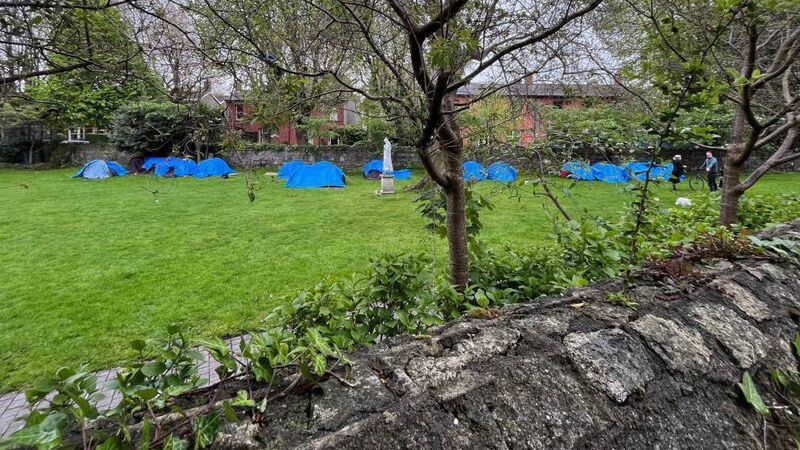Concerns over the new EU pact on migration

Tents occupied by asylum-seekers in Ballsbridge, Dublin
NEGOTIATED over almost ten years, the EU’s New Pact on Migration and Asylum was adopted by MEPs in the European Parliament in April. The new rules entail tougher measures to respond to migration.
The Pact was referred to the Oireachtas Joint Committee On Justice to be scrutinised. While Taoiseach Simon Harris assured it would come back before the Dáil, some TDs expressed concerns about the lack of debate on the matter.
In order to implement the Pact, the Minister for Justice will put in place a range of measures which will include the full repeal of the International Protection Act 2015.
The Taoiseach has said the overhaul of EU migration and asylum policy would result in a “fair but firmer” migration system. He added that Ireland would “disproportionately benefit” from the rules of the Pact as it is an EU country primarily concerned with so-called “secondary movements” of refugees.
But is the new Pact something Ireland can “benefit” from, and does it propose a “fair but firmer” system?
The Pact introduces a number of reforms, including accelerated asylum procedures, a solidarity mechanism for EU countries during times of migratory pressure, as well as the expansion of the role of Eurodac (EU’s fingerprint database for asylum seekers).
One of the expected benefits for Ireland would be enhanced solidarity with the 26 other Member States. A complex solidarity mechanism will establish a ‘solidarity pool’, whereby all EU countries will have flexibility as to how they will contribute during times of migratory pressure. For example, Member States can contribute by relocating asylum applicants to their territory. There is a minimum annual requirement to relocate 30,000 asylum seekers from Member States that receive the most arrivals in the EU to Member States that receive considerably less.
Alternatively, Member States can make a financial contribution under the mechanism, which will be fixed at €600 million.
It is important to note that Member States have full discretion as to the type of solidarity they choose to contribute.
Additionally, a key element of the asylum procedures regulation is the ‘Safe Third Country’ concept, which allows Member States to return refugees to countries they deem safe. The European Council on Refugees and Exiles (ECRE) warned that the regulation lowers the threshold for a country to be classed as “safe” and the Pact could allow for Member States to send people to supposedly “safe parts” of non-safe countries.
Other human rights groups, including Amnesty International and Médecins Sans Frontières have decried the Pact’s consolidation of harmful practices such as procedures at EU borders where people are subject to containment which can result in de facto detention, as has been the case in Greece and Italy.
While it may be true that Ireland will benefit from enhanced solidarity with other EU countries, it is clear the Pact presents grave human rights concerns which will benefit no one, least of all people seeking refuge.
The latest Eurobarometer surveylast month found that 42% of Irish citizens cite migration and asylum as the main issue they would like to see discussed during the European Parliament electoral campaign.
There is currently a severe shortage of accommodation for refugees in Ireland due to the long-running housing crisis. According to the most recent figures from the International Protection Office (IPO), 1,717 people are still awaiting an offer of accommodation, with some forced to sleep in tents outside the IPO on Mount Street in Dublin in recent months.
Concerns around housing, resources, and lack of consultation with local communities, at times manipulated by far-right groups, have driven anti-migration protests around the country.
On April 18, a small group of individuals with banners featuring anti-migration slogans gathered outside the home of Minister for Integration, Roderic O’Gorman, in Dublin.
Executive director of the United Nations Population Fund, Dr Natalia Kanem, referred to concerns that refugees coming to Ireland are facing “scapegoating and discrimination”.
In 2023, the number of first-time asylum applications in Ireland was 251 per 100,000 inhabitants, higher than countries such as Italy, Portugal and France, but lower than countries such as Spain, Germany and Austria.
According to data by UNHCR, as of mid-2023, the total refugee population in Ireland was 99,048, about 1.9% of its total population. Germany’s figure is about 3%, Poland’s is 2.7%.
Research has challenged the view, often promoted by right-wing actors, that the past decade has seen an upward trend of an “ever-increasing” refugee population worldwide. According to UNHCR data, refugee numbers fluctuate in response to levels of conflict and crisis in refugees’ origin countries. Ireland is no exception to this.
Applications for international protection in the EU declined by almost a half between 2016 and 2019. However, since 2020, there has been a steady rise in the EU and Ireland. Despite this, in the last four years, the EU and, in turn, Ireland continues to receive only a small share of the world’s refugees, over half of whom come from just three countries (Ukraine, Syria and Afghanistan). In fact, the EU’s share of the global refugee population has significantly decreased, from 70% in 1993 to under 20% since 2018. About 74% of refugees are hosted by low-income and middle-income countries.
The EU’s Pact on Migration and Asylum may propose “firmer” migration management but the notion it is “fair” risks promoting a narrative that obscures some of the real risks: that it will undermine states’ obligations to protect people fleeing war and human rights violations.
This approach also removes agency from those central to the conversation on migration - those who have a legal right to international protection.
If Irish citizens want to see migration discussed in this electoral campaign, let’s ensure those discussions are fair but firm when it comes to human rights.







 App?
App?







